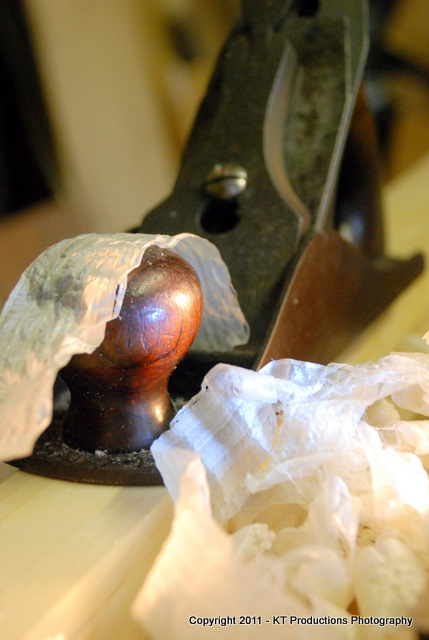For a long time I've been of the opinion that hand planes are the tools of the devil, so to speak - horrible to use, hard to get a good result with, etc., and I've been using power tools for all the things people might use a plane for - mostly a random-orbit sander and a router, occasionally even an electric planer (which I hate).
Recently I've been more and more getting the opinion that it's partly because all the planes I've used over the years have been badly set up and/or not sharp enough, and there's still the odd task I'd like to be able to avoid power-tools and the associated noise and dust for. So I recently bit the bullet, did some research and waste... uh, spent an evening sharpening a cheap smoothing plane, then grinding and filing bits of it so that the bottom is vaguely flat and the frog holds the blade half-decently and the chip-breaker doesn't catch everything that comes through the mouth and jam full of shavings all the time, and so on. (And what did I get for my trouble? It bit me, which was new.)
The result is that I still think it's a tool of the devil, but I'm coming around to the idea that it may just be because I'm using a crappy cheap plane which was put together by brain-damaged rhesus monkeys using ancient, worn tooling and the worst steel they could lay their hands on. I'm interested in trying a better-quality plane, but I don't want to spend the silly money I see a lot of quality planes going for, because I'm still wary I may not use it that much, and I'd like to go for as generally-useful non-specialised a tool as possible, but since I've been avoiding hand-planing I don't really know what that might be.
To round off an unnecessarily-long story, can anyone suggest a good-enough-to-not-put-me-right-off-again-but-reasonably-priced-enough-to-not-put-me-off-before-I-even-start plane that a hand-planing novice like myself isn't going to kill themselves trying to set up properly? I'm deliberately not stating an outright budget 'cause I'd like to know what the price of a decent-enough tool is, not what the best thing I could get for £X is...
Recently I've been more and more getting the opinion that it's partly because all the planes I've used over the years have been badly set up and/or not sharp enough, and there's still the odd task I'd like to be able to avoid power-tools and the associated noise and dust for. So I recently bit the bullet, did some research and waste... uh, spent an evening sharpening a cheap smoothing plane, then grinding and filing bits of it so that the bottom is vaguely flat and the frog holds the blade half-decently and the chip-breaker doesn't catch everything that comes through the mouth and jam full of shavings all the time, and so on. (And what did I get for my trouble? It bit me, which was new.)
The result is that I still think it's a tool of the devil, but I'm coming around to the idea that it may just be because I'm using a crappy cheap plane which was put together by brain-damaged rhesus monkeys using ancient, worn tooling and the worst steel they could lay their hands on. I'm interested in trying a better-quality plane, but I don't want to spend the silly money I see a lot of quality planes going for, because I'm still wary I may not use it that much, and I'd like to go for as generally-useful non-specialised a tool as possible, but since I've been avoiding hand-planing I don't really know what that might be.
To round off an unnecessarily-long story, can anyone suggest a good-enough-to-not-put-me-right-off-again-but-reasonably-priced-enough-to-not-put-me-off-before-I-even-start plane that a hand-planing novice like myself isn't going to kill themselves trying to set up properly? I'm deliberately not stating an outright budget 'cause I'd like to know what the price of a decent-enough tool is, not what the best thing I could get for £X is...






































